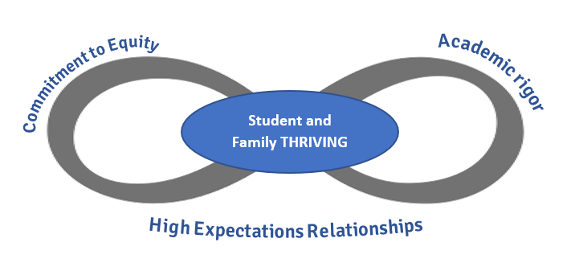
Transformative Educational Leadership Journal | ISSUE Spring 2023
In a unique approach to inquiry, Kerri Steel offers a way of thinking about the work of transforming schools from places of learning to learning environments where students and families thrive.
By Kerri Steel
In this post-pandemic world, many school teams struggle to balance their beliefs and support for complex learners with the beliefs or expectations of parents and caregivers. Folks worry there’s not enough help for the children who need it and that giving help to some learners means help is unavailable for others. In this post pandemic context “various stakeholders hold to the perception that the equity goals are in tension with academic rigour rather than the view that commitment to equity strengthens learning and teaching” (Datnow et al., 2022, p. 36). Finding ways to move forward collaboratively and in relationship is critical for student, community, and educator wellness and resilience. Our steps must be taken with intention and in alignment with the values of quality and equity. Each step we take is a decision opportunity.
The Decision Playbook (Failing et al., 2019) provides a framework for strategic decision making, helping educators address complex circumstances without feeling overwhelmed. Now, more than ever, educators must take the time to clarify what matters, and ensure they take strategic steps in alignment with these values.
Move #1: Frame the Choice
Current tensions manifest in a multitude of ways, creating space for decision making:
-
- Parents assert that specific programming be provided for their children.
- Doctors or clinical counsellors suggest specific assessments, education assistant support, or a specific intervention.
- Staff express concern regarding the implementation of highly individualized accommodations for dysregulated students.
- Community agencies advocate for specific graduation pathways and post-secondary choices for students with identified needs.
How we frame decisions matters. Using a binary frame limits us unnecessarily. For example, push-in or pull-out intervention? Mainstream or specialized program? Academics or life skills classroom? Where educators find themselves faced with an either/or decision, it’s critical they pause and reframe. Multi-tiered systems of support are a continuum. Inclusion is a personalized pathway of opportunities that create the most opportunity and access for the learner. Little bit push-in, little bit pull-out. Little bit mainstream, little bit individualized.
There’s a misguided sense that providing a variety of ways to engage with the curriculum somehow diminishes rigour, or that personalizing our interactions and approaches for supporting students with behavioural needs somehow lowers expectations for them. The outcome of this tension can be strained or fractured relationships with parents and other stakeholders. Despite sharing a common goal, we may not share a common understanding of how to achieve it.
Move #2: Clarify What Matters
Clarifying what matters as we make key decisions is crucial because it saves us from being distracted by all of the competing perspectives and requests. The tension present in our context is resolved through establishing deep, collaborative, relationships between families, community partners, and school teams.
Brooke Moore (2023) encourages us to engage in work that is both values-based and evidence-informed. This engagement requires empathetic listening – “the ability and willingness to comprehend another person’s thoughts, feelings and struggles from his or her vantage point and to help the acquaintance generate new meanings” (Berkovich & Eyal, 2020, p. 139). This is where we will find our common goal.
As I reflect on our current context, I have come to agree with Hannon and McKay’s assertion that “the concept of thriving offers a fertile way forward” (2021, p. 6). As illustrated in Figure 1, we need to center the notion of students and families thriving, supported by high expectations relationships. This allows us begin to resolve the tension between a commitment to equity and the desire for academic rigor.

Figure 1: Students Thriving: Balancing Equity, Rigor and Relationships.
I’ve been working on an inquiry project to help generate strategies for resolving this tension. As educators, we need to develop networks that extend beyond the schoolhouse, and authentically draw on the wisdom, knowledge, and relationships with others caring for our children. In my experience, the following two questions help school teams focus this collaborative work. These questions are re-frames of the questions Judy Halbert and Linda Kaser encourage through the Spirals of Inquiry (2022):
-
- Can every parent identify two educators who are listening with curiosity and empathy, and who really believe in their child’s success?
- What are we learning, and why is it important?
The Coast Salish people on Vancouver Island describe the connection between hearts and minds as qwam qwun tthun’ shqwaluwun. I love the way Snuneymuxw Elder Jerry Brown describes it. He says this is when your heart and your mind get along.
For me, that’s the essence of the values that lay beneath this moral imperative to create high expectations relationships with families and the others who support them. Timperley et al. (2020) explain that “historically, emotion, cognition and motivation were considered separate and oppositional processes … now it is clear that they, in fact, work together in complex, inseparable ways.” Fullan argues that “what gives humans meaning in life is: a strong sense of identity around a purpose or passion; creativity and mastery in relation to a valued pursuit, and connectedness with the world and others” (as cited in Watkins et al., 2018, p. 7). If we keep these values at the heart of our decisions, the options we seek will be more aligned with the equity goals we seek.
Moves #3 and #4: Generate Options & Explore Consequences
As we generate options and explore how they impact the values of equity, academic rigor, and high expectations relationships, we move into creative and new territory – leaving binary choice-making in the past. Educational leaders know the importance of bringing clarity to expectations and goals prior to engaging staff in collaborative work. Leaders play a key role in helping others deeply understand what matters and how certain options can benefit equity work. Margaret Wheatley notes that “to heal the system, we must connect the system to more of itself” (as cited in Watkins et al., 2018, p. 17). Leaders who recognize the critical importance of nurturing this stance will be agile enough to “enable leaders to adjust, learn and iterate throughout the improvement process, in order to gain their desired impact amidst changing conditions” (Hannon & Mackay, 2021, p. 10).
Move #5: Weigh the Trade-offs and Decide
Educators are not able to do this work alone. So much of our work involves families, medical and clinical professionals, behaviour interventionists, advocates, and agencies who engage with our learners and their families outside of school. School teams regularly interact with individuals who provide recommendations and services for families and students, and outside assessors generate many of the assessment reports we consider when developing personalized plans for our students.
These professionals need to understand how much we value collaboration with them, while also developing a fulsome and accurate understanding of our processes, resources, and models of support.
To enhance systems and structures and support learners in ways that allow them to truly thrive, we need to create “platforms, alliances and networks to accelerate and amplify powerful professional practices that will create new and richer pathways for learners” (Hannon & Mackay, 2021, p. 10). These relationships can be strengthened in shared decision making and also in how we communicate our decisions. If the pandemic has taught us anything, it’s that we’ve spent enough time on our own. This disconnection is fatiguing and frustrating. It isn’t getting us where we need to be. Developing powerful networks is truly essential for ourselves, for our learners, and for our community to thrive.
Stay Curious
The concerns and tensions that are part of these relationships invite us to stay curious. Educators don’t need to have all the answers. We do need to grow the community of folks we engage with in our decision making – in our moves to action. And we need to stay curious about how our decisions impact our progress and the individuals involved as we go. We can learn just as much from good decisions as we can from decisions that don’t turn out as well as we had anticipated. Together, we can grow a powerful and impactful connection between our hearts and minds – our qwam qwun tthun’ shqwaluwun.
- Berkovich, I. & Eyal, O. (2020). Toward a new model of emotional leadership in schools.(135-151) and Conclusion (152 – 158). In the book: A model of emotional leadership in schools: Effective leadership to support teachers’ emotional wellness. Routledge.
- Datnow, A., Park, V., Peurach, D., & Spillane, J. (September 2022). Transforming education for holistic development: Learning from education system (re)building around the world.Center for Universal Education at Brookings.
- Failing, L, Gregory, R, Long, G & Moore, B. (2019). The Decision Playbook: Making thoughtful choices in a complex world. Delta School District.
- Halbert, J. & Kaser, L. (2022). Leading through spirals of inquiry forequity and quality. Portage and Main Publishing House. Chapter 6: New Professional Learning: Designing for Change.
- Hannon, V. & Mackay, T. (August 2021). The future of educational leadership: Five signposts. CSE Leading Education Series. Centre for Strategic Education, Melbourne.
- Moore, B. (February 11, 2023). Decision Making: Thoughtfulness amidst complexity.
- Timperley, H., Ell, F., Le Fevre, D., & Twyford, K. (2020). Leading professionallearning: Practical strategies for impact in schools.ACER Press. Chapter 3: Emotion, uncertainty and vulnerability, (45-62), p.47.
- Watkins, J., Peterson, A.J., & Mehta, J.D. (October 2018). The deeper learning dozen: Transforming school districts to support deeper learning for all: A hypothesis. Discussion paper, p.7.
 Kerri Steel
Kerri Steel
I really appreciate your illustration of the ways in which using the decision framework takes us beyond binary thinking and to a place of empathy and understanding.
Thank you for this wonderful article . I fully agree with your design and ideas and your writing made it clear to me. Need to practice now
Cheers